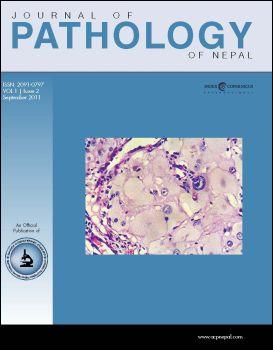Estrogen and progesterone receptor expression in breast carcinoma
DOI:
https://doi.org/10.3126/jpn.v1i2.5401Keywords:
Breast carcinoma, Estrogen receptor, Progesterone receptorAbstract
Background: Breast carcinoma is the most common malignancy diagnosed among women worldwide and second leading cause of cancer mortality. One of the hallmarks of the disease is expression of estrogen receptor and progesterone receptor that ultimately drives prognosis and treatment modalities of the patient. The objective of this study was to determine the Estrogen and Progesterone receptor status in relation to histological grade of tumor.
Materials and Methods: This was an observational study, carried out in the department of Pathology, BP Koirala Memorial cancer Hospital, Bharatpur, from January 2010 to December 2010. A total of 136 patients with histological proven diagnosis of breast carcinoma was included in this study. These cases were graded according to the modified Bloom and Richardson criteria into three histological grades. We used immunohistochemistry to evaluate the expression of Estrogen and Progesterone in relation to histological grade of tumor.
Results: Out of 136 cases, there were 131 (96%) cases of infiltrating ductal carcinoma with mean age of 48 years. Majority of cases were grade II (59%) followed by grade III (21%) and grade I (20%). Estrogen Receptor and Progesterone Receptor expression were seen in 28% and 19% respectively. In grade I, 16 (59%) and 10 (37%) cases out of 27 were Estrogen Receptor and Progesterone Receptor positive respectively. In grade II, 21 (26%) and 15(19%) out of 80 cases were Estrogen Receptor and Progesterone Receptor positive respectively. In grade III, 1(3%) and 1 (3%) cases were positive for Estrogen Receptor and Progesterone Receptor respectively.
Conclusions: Expression of estrogen and progesterone is comparable to west with Estrogen and Progesterone showing inverse association with histological grades of tumor.
Keywords: Breast carcinoma; Estrogen receptor; Progesterone receptor
DOI: http://dx.doi.org/10.3126/jpn.v1i2.5401
JPN 2011; 1(2): 100-103
Downloads
Downloads
How to Cite
Issue
Section
License
This license enables reusers to distribute, remix, adapt, and build upon the material in any medium or format, so long as attribution is given to the creator. The license allows for commercial use.




